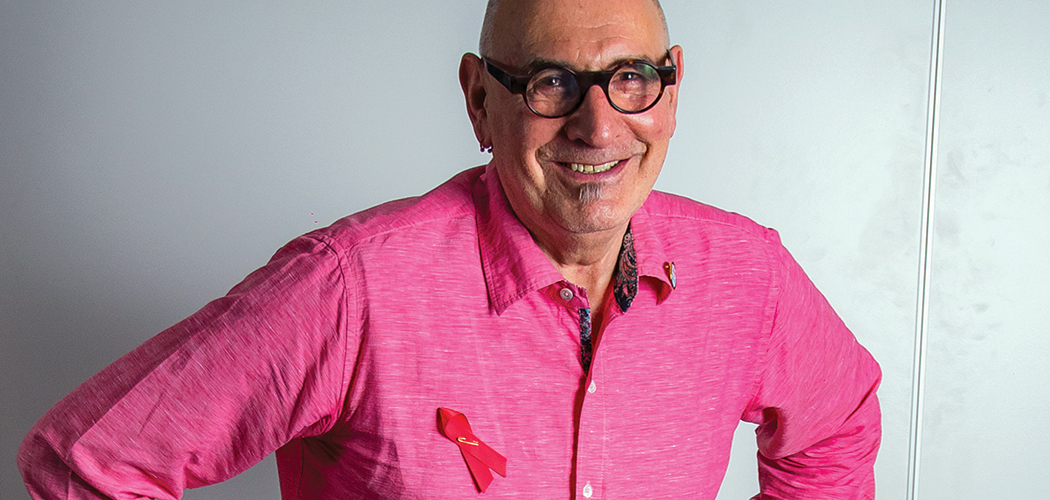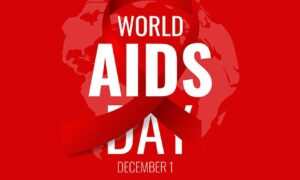Jonathan Blake is one of the country’s oldest surviving people with HIV. Jonathan, who is 70 this year, was the basis for the character played by Dominic West in the film Pride. Jonathan and his long term partner Nigel Young were actively involved in Lesbians and Gays Support the Miners in the 1980s. The couple have been together for 36 years. Jonathan had a career as an actor and worked in the London Coliseum’s costume department. He has also recently appeared in The Grass Is Always Grindr.
“I was the first person diagnosed at the Middlesex Hospital. So my number at the Middlesex Hospital was L1 – ‘London One’ – that was October 1982.
Back in February 1981 a really dear friend of mine from San Francisco got married. I had an ex-lover who was living in San Francisco, so I thought perfect, I can go and stay with George and do the wedding and also I can spend time in San Francisco. And of course, I love steam baths, I’ve always loved steam baths, and there were some amazing ones.
So I went to the steam baths in San Francisco. And at that point, although there was a sense of unease it really hadn’t kind of exploded in the way that it was about to. I come back, and go back to working in Joe Allen’s restaurant. I was really fortunate that whenever I was out of work as an actor, I used to go and work at Joe Allen’s.
I’m working there and in about July 1982, I start to notice that my lymph nodes have got large, and they got bigger and bigger and more painful. I began to feel unwell, and I really didn’t feel like I could work. My lymph nodes were really up. I walked like a gorilla. I couldn’t keep my legs together, my arms were out, and it was just really painful.
I’d always gone to James Pringle House, it was central. Most of the STI clinics were horrendous back in the 60s and 70s. Hidden away, dark, dank but James Pringle House was actually quite pleasant. I presented myself there and they just kind of looked at me, and thought this is odd. They’d never seen anyone with so many lymph nodes and so big. So they said we’re going to take you in, we want to do a biopsy.
After two days they come in and they give me this diagnosis. They tell me that I have a virus which is called HTLV-3. It’s a terminal diagnosis, there is nothing that they can do for me and there will be palliative care. And I’m 33.
And that’s it. And then they release me and I go home. I was shell-shocked. I cut myself off. I didn’t know how to deal with it. I didn’t want to deal with it. There were no mobile phones, no computers but somehow one is hearing stuff. Capital Gay was the main news sheet and all one was hearing was that people were getting ill and it was young people, and that they were dying from these unusual diseases like Pneumocystis pneumonia, CMV retinitis and Kaposi’s sarcoma.
It was these opportunistic infections that were killing people. It wasn’t the virus. The virus was purely just gnawing at your immune system and making it rubbish. The hospital would call me in weekly just to check. They were doing MRI scans of the brain and the body and really looking to see what was was going on. Somebody came up with the name HIV – which is just human immunodeficiency virus. One was being looked after, but there was still no treatment.

Then there came this point, which must have been I think 1988, and they were deciding to use AZT which was a failed chemotherapy drug. They were doing this trial called the Concorde trial. The people on it were already sick, but they were getting sicker because of the drugs they were getting. For years I was angry about this whole trial.
In about 1989 my CD4 count fell to 200 and at that point 200 was an AIDS diagnosis. So now this was serious. It wasn’t that I was feeling unwell, but it was like that’s it, I have now got an AIDS diagnosis.
My friend George who I’d gone to stay with in San Francisco, had moved on to Australia and then Thailand where he met a partner. He came back to this country and he was ill with HIV-related lymphoma. He was in the London Lighthouse. He was really, really ill. I mean what is amazing is that he is still around today, he also survived and his hospital number was L5.
In 1996 my health gave out. We’d had a really heavy show, we were doing 16-hour days over ten weeks. I’m 40 and I got this immune deficiency disease. I got shingles internally on my phrenic nerve. Once I got over the shingles, I’d got no energy, I was just so lethargic.
What was fortunate was that this was 1996 and they were beginning to have the combination therapies. I went to see my consultant at King’s and he said you know you are going to have to bite the bullet and start. He worked out a combination for me – so it was D4T, DDI and Nevirapine.
So we started on it and I remember the first week: nothing. Second week: nothing. Third week: nothing. I’m thinking why am I doing this? I’m putting all these pills in me. I was just feeling that nothing was happening. I wake up on the fourth week and I have got unbelievable energy. It was incredible! It was like Atlas reborn. I could have carried the world on my shoulders. I had got so much energy that I laid a patio outside my French windows. I’ve never done anything like that. It was extraordinary. It was like Lazarus raised. I couldn’t believe it and at that point I realised that the drugs were working.
I am now on this wonder drug Darunavir. My viral load is undetectable, and my T cells are about 400. What has been the most incredible thing, and to me the most important, is the fact that if you’re undetectable, you can’t pass the virus. Once that was published it completely changed one’s psychology. The very fact that I know that I’m on effective treatment, that I can’t pass this virus, is so liberating.”
Photos by Joel Ryder














